Françesca’s fifth birthday is coming up in March.
Karl: Who do you want to see your drawings?
Fran: All the people from the whole world, and also grandma and grandpa.
a multi-disciplinary dialog
Françesca’s fifth birthday is coming up in March.
Karl: Who do you want to see your drawings?
Fran: All the people from the whole world, and also grandma and grandpa.
Saturday morning, eight am, and still no post ready.
I have a good reason: I’ve been too busy drawing to write; moreover, I certainly have little time or patience for image manipulation with a computer.
Many people think of underpainting as a working in monochrome — either in grays, or browns. Artists of the past like Jan van Eyck used very colorful underpaintings. The usefulness of this I see in my painting of grapes.
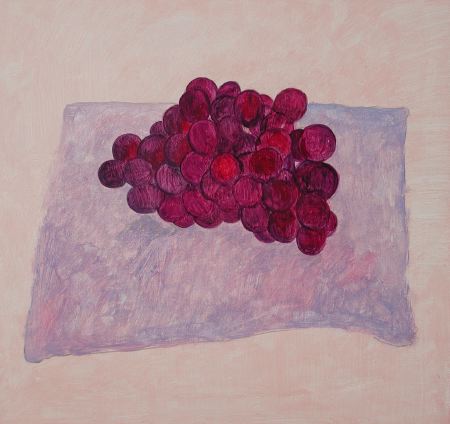
I was painting these grapes from some dark purple-blue grapes in my studio. I made the underpainting much more bright, and warm, than real grapes, as you can see in the picture above.
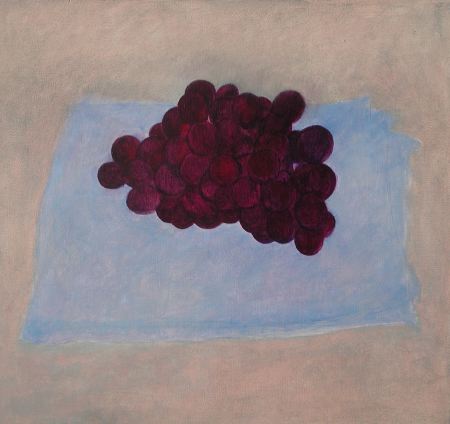
When the first layer of oil paint was dry, I began overpainting, putting darker shadows over the grapes to make the colors more realistic, darker and cooler, as you can see above.
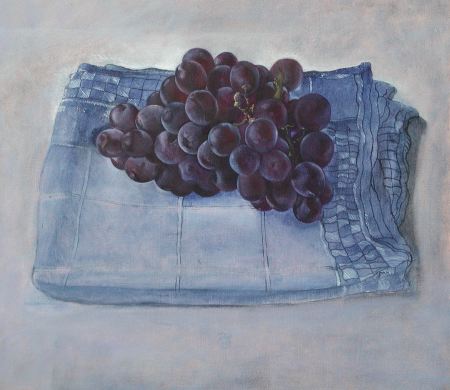
Here I have gone further with overpainting in another session. Now the grapes have a realistic color, but the brightness of the underpainting color shows through and gives life to the colors. If I had started with dark gray grapes, instead of a colorful underpainting, the colors would be dead when I did the overpainting. This this picture is not quite finished in the cloth. Here is where I left it yesterday afternoon.
Any suggestions?
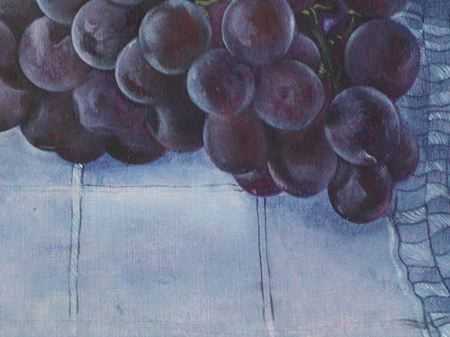
(detail requested by Steve)
Possible points of interest in posts and comments:
(1) Information on artistic methods applicable to several disciplines
(2) Practical aspects – framing pictures, book keeping, time keeping
(3) Creative process in art
(4) Art history
(5) Other interests
Please feel free to criticize and add other interests. We can continue discussing them in future.

I am interested in motion in a 3-dimensional context (5). My photograph barely captures the sharp drop-off to the lake and there is no motion to speak of. How can this landscape be imaged in a more interesting way? Would it help to change the medium?
more… »

Not long ago, Françesca enjoyed typing random letters into a text editor for about ten minutes a day. Now that she is nearing five years old, that doesn’t satisfy her any longer. She learned how to use the mouse, and she’s beginning to understand how to use the Safari web browser. She can spend an hour on-line without a break.What to do? This is the point where Hanneke and I have a choice. We can take the computer away and have our kids grow up in a “traditional” pre-internet household. Or we can let them go online and accept the consequences.
I am of two minds about this. One view is that the kids should be able to grow up in an internet-free home, the way we grew up. The opposing view is that the kids should go online because the internet is part of the world we live in — keeping the kids away from it would be like refusing to let them learn to read or write.
I am torn between these two views, but I am leaning toward letting her go online because:
Anyone else out there with similar problems / opportunities?
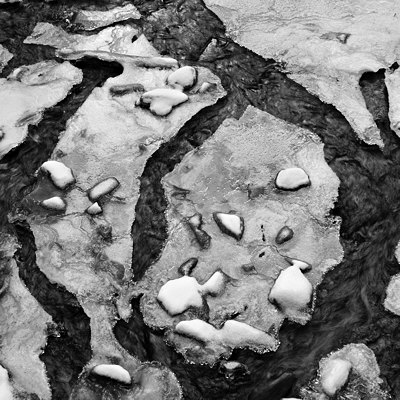
I’ve always loved Minor White‘s dictum to photograph something not only for what it is but also for “what else it is.” His images that accord best with that idea tend to be ambiguous ones of rocks, frost on windows, etc. I don’t really know whether or not he had clear ideas with particular images what else they were of. Which would be just like I don’t for the image above. But I do have a kind of feeling that it’s about more than a frozen stream at the base of Pine Creek Falls at the northern end of (I kid you not) Paradise Valley.
I’ve described Narrative gaps as one of the most powerful ideas that I’ve come across for helping to understand why people like certain artworks and not others.
The idea first surfaced in a blog by Hugh Macleod. Hugh is a marketing man so the idea was expressly connected to selling, but can be applied to finding any sort of audience for any sort of product, including art, both commercial and non-commercial.
Broadly the idea goes that people will like your work if it fits into their story. They will like it a lot (maybe enough to buy it) if it helps fill out their story and make it more complete.
This is, perhaps, best explained by example. You make pictures of wild landscapes….your audience isn’t going to be made up of people who think that a short walk on Steatham Common is the closest to nature that they ever want to get. You will have more luck with people who choose to live in and around the wild places, but probably not much. Your best market would be people who think that they want to live in such wild places. You are in the story and you help them live it a little more than they could otherwise.
Please note that the actual artwork hasn’t yet been mentioned. You can show the same work to a petrolhead, a rock climber, a farmer, and a big city commuter who wants out, and get radically different reactions according to a complex mix of whether your work is in their story or out of it, and whether it fills a gap in that story or doesn’t.
Take this picture:
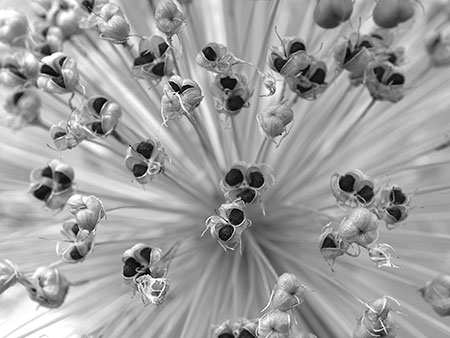
It is from this short series – you can see a larger version by following the link.
I’ve chosen that particular picture to display here because I once swapped a copy of it with Steve Durbin.
During the preparation of this article I asked Steve why he chose that picture and he kindly agreed to write about it:
I wanted that Allium print for three reasons. First, I wanted to study how you handled composition with a frame-filling subject, and how in-focus and out-of-focus elements played off each other. These were things I was struggling with in my own work (Sourdough Trail series). Second, I wanted it for my wall because I enjoyed the combination of softness and precision in the image, and the overall grace and lightness. And lastly, it represented a point of contact in my search for a community of serious photographers. I don’t think this makes a great example of a typical purchase for me, but if I were to put it in terms of “narrative gaps,” I would say that the print represented several things that the narrative of my artistic life was missing at the time.
Notice that only one of the three things that Steve mentions is directly connected to the image as an image. His first point is a craft point and his third point is a social one.
At its most basic, the narrative gap idea explains why postcards of sunsets sell. They can be tedious pictures. Indeed the buyers sometimes recognise them as such, but they can hit the buttons in terms of filling a gap in their lives. They want there always to be beautiful sunsets and they want to be the sort of person who gets up and goes out to notice. Paul Butzi has written more about this recently.
It can be instructive when looking at a piece of art to work out why it appeals, or doesn’t, in terms of your own story and any unfulfilled parts thereof. But it is more instructive to realise that the fact that you like an artwork and somebody else doesn’t says more about your respective personalities than it does about the artwork.
So, if all this means anything, what are the consequences? Well, it means that if you can spot a narrative gap shared by a large group of people and then produce something to fill it, you might sell quite a lot (let’s ignore the question about whether this stops it being art). Similarly, if you produce what you happen to want to produce but want to maximise your audience, then you have to work out what sort of person is likely to be in your audience. Chasing the wrong people will be frustrating, because such a small part of your success in finding an audience is directly related to the quality of your art.
And now back to the soap powder commercials.